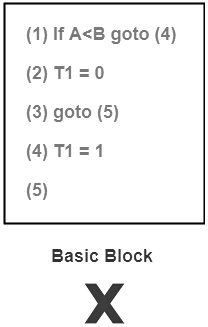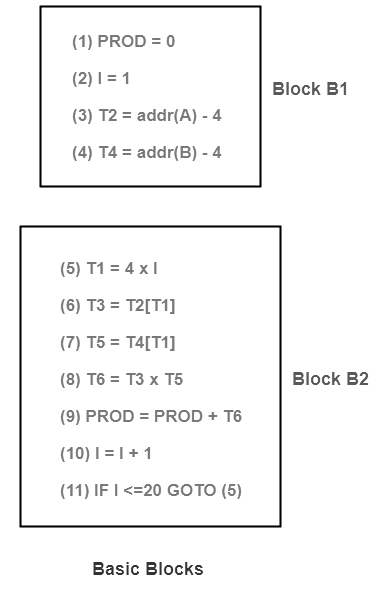Computer Science Engineering (CSE) Exam > Computer Science Engineering (CSE) Notes > Compiler Design > Basic Blocks & Flow Graphs
Basic Blocks & Flow Graphs | Compiler Design - Computer Science Engineering (CSE) PDF Download
Basic Blocks
The characteristics of basic blocks are-
- They do not contain any kind of jump statements in them.
- There is no possibility of branching or getting halt in the middle.
- All the statements execute in the same order they appear.
- They do not lose lose the flow control of the program.
Example of Basic Block
Three Address Code for the expression a = b + c + d is-
Here,
- All the statements execute in a sequence one after the other.
- Thus, they form a basic block.
Example of Not a Basic Block
Three Address Code for the expression If A<B then 1 else 0 is-
Here,
- The statements do not execute in a sequence one after the other.
- Thus, they do not form a basic block.
Partitioning Intermediate Code Into Basic Blocks
Any given code can be partitioned into basic blocks using the following rules-
Rule 1: Determining Leaders
Following statements of the code are called as Leaders
- First statement of the code.
- Statement that is a target of the conditional or unconditional goto statement.
- Statement that appears immediately after a goto statement.
Rule 2: Determining Basic Blocks
- All the statements that follow the leader (including the leader) till the next leader appears form one basic block.
- The first statement of the code is called as the first leader.
- The block containing the first leader is called as Initial block.
Flow Graphs
A flow graph is a directed graph with flow control information added to the basic blocks.
- The basic blocks serve as nodes of the flow graph.
- There is a directed edge from block B1 to block B2 if B2 appears immediately after B1 in the code.
 |
Download the notes
Basic Blocks & Flow Graphs
|
Download as PDF |
Download as PDF
Problems Based on Basic Blocks & Flow Graphs
Problem 1: Compute the basic blocks for the given three address statements-
- PROD = 0
- I = 1
- T2 = addr(A) – 4
- T4 = addr(B) – 4
- T1 = 4 x I
- T3 = T2[T1]
- T5 = T4[T1]
- T6 = T3 x T5
- PROD = PROD + T6
- I = I + 1
- IF I <=20 GOTO (5)
We have-
- PROD = 0 is a leader since first statement of the code is a leader.
- T1 = 4 x I is a leader since target of the conditional goto statement is a leader.
Now, the given code can be partitioned into two basic blocks as-
Problem 2: Draw a flow graph for the three address statements given in problem-01.
- Firstly, we compute the basic blocks (already done above).
- Secondly, we assign the flow control information.
The required flow graph is
The document Basic Blocks & Flow Graphs | Compiler Design - Computer Science Engineering (CSE) is a part of the Computer Science Engineering (CSE) Course Compiler Design.
All you need of Computer Science Engineering (CSE) at this link: Computer Science Engineering (CSE)
|
26 videos|67 docs|30 tests
|
Related Searches























